▼ Nedumkayam: India's first fully digital tribal colony [12-30-16]
 Nedumkayam colony in the Karulazhi panchayat in Malapuram District of Kerala became the first fully-digital tribal colony in the country. Nedumkayam colony in the Karulazhi panchayat in Malapuram District of Kerala became the first fully-digital tribal colony in the country.
It is located about 400 kms from Kerala’s capital Thiruvananthapuram.
Declaration was made after adequate training for the entire tribal people of the colony in digital literacy and cashless transaction.
The training was completed with the support of National Service Scheme (NSS), volunteers of an
Arts and Science College at Kondotty and Jan Sikshan Sansthan, of Malappuramdistrict.
The Adivasi colony at Nedumkayam has become the first tribal community in the country to go digital.
The tribal colony in Karulai panchayat within the Nilambur forests was declared cashless on 27th Dec 2016.
District Collector Amit Meena and P.V. Abdul Wahab, MP, jointly declared the colony digital at a function held at Nedumkayam in the afternoon.
The Adivasis transferred Rs. 5 to the District Collector’s bank account using online technology.
The Adivasis were given training in digital transactions as part of the Digital Malappuram,
Cashless Malappuram programme being implemented by the district administration. The tribal colony got special attention after Mr. Wahab adopted Karulai as a model panchayat under the Saansad Adarsh Grama Yojna (SAGY) scheme of the Central government.
The SAGY scheme put forth by Prime Minister Narendra Modi envisages that every MP transforms one village in their constituency into a model village by this year-end.
The Jan Sikshan Sansthan (JSS), which won this year’s UNESCO Confucius Prize for Literacy for its innovative work among tribals, had provided computer and internet facilities at the community centre of the Nedumkayam colony.
The Adivasis of Nedumkayam were given training in digital transactions with the help of National Service Scheme (NSS) volunteers of EMEA College, Kondotty.
A tribal volunteer has been appointed for further training for a year.
|
▼ China launches remote sensing satellites Super View 1 01/02 [12-29-16]
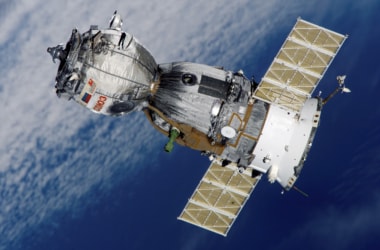 China on 28th Dec 2016 successfully launched a pair of high-resolution remote sensing satellites to get commercial images. China on 28th Dec 2016 successfully launched a pair of high-resolution remote sensing satellites to get commercial images.
The satellites were launched from the Taiyuan Satellite Launch Centre in Shanxi Province.
The satellites, SuperView-1 01/02, blasted off at 11:23 am Beijing time on the back of a Long March 2D rocket.
They are able to provide commercial images at 0.5-meter resolution.
The satellites launch followed release of a white paper on 27th Dec which said China plans to form a BeiDou network consisting of 35 satellites for global navigation services by 2020.
It is expected to compete with America's Global Positioning system.
China plans to start providing basic services to countries along the Silk Road Economic Belt and 21st-century Maritime Silk Road in 2018, it said.
Besides satellite services, the paper said China will launch a lunar probe in 2018 to achieve world's first soft landing on the far side of the moon.
Super View 1 01/02
- GaoJing-1, also known as SuperView-1 is a constellation of Chinese civilian remote sensing satellites.
- It is operated by Beijing Space View Tech Co Ltd.
- Constellation initially consists of two satellites.
- It operates at an altitude of 500 km and provides imagery with 0.5 m panchromatic resolution and 2 m multispectral resolution.
- The swath width is 12 km and the satellites are spaced by 180° on the same orbit.
- The first pair was launched on 28 December 2016 on a CZ-2D (2) rocket. A second group of two satellite of this type is planned for 2017,
- This brings the constellation to four satellites phased 90° from each other on the same orbit.
|
▼ India successfully test fires nuclear capable ICBM Agni 5 [12-28-16]
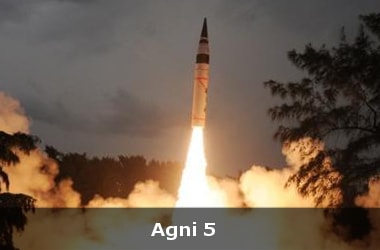 India successfully test-fired on 26th Dec 2016 its nuclear-capable, inter-continental ballistic missile Agni 5, which has a range of over 5,000 km covering whole of China, from Abdul Kalam island off Odisha coast. India successfully test-fired on 26th Dec 2016 its nuclear-capable, inter-continental ballistic missile Agni 5, which has a range of over 5,000 km covering whole of China, from Abdul Kalam island off Odisha coast.
The successful test-firing will pave way for the user trial of the most potent Indian missile and its eventual induction into the special forces command (SFC).
The 3-stage, solid propellant surface-to-surface missile was test-fired from a mobile launcher from launch complex-4 of the Integrated Test Range (ITR).
About 17-metre long and weighing over 50 tonnes, the surface-to-surface missile majestically rose from the confines of its canister flawlessly and achieved all targets.
It is the 4th developmental and 2nd canisterised trial of the missile.
While the first test was conducted on April 19, 2012, the second was on September 15, 2013 and the third on January 31, 2015 from the same base.
More About Agni
- This was the first test of the Agni-5 missile after India became a member of the Missile Technology Control Regime.
- The 17-metre long Agni-5 Missile weighs about 50 tonnes and is a very agile and modern weapon system.
- The Agni-6 is reported to be in early stages of development with a strike-range of 8,000-10,000 km.
Agni-5 is the most advanced nuclear capable missile with the following new technologies:
- Ring Laser Gyro based Inertial Navigation System (RINS) and
- Micro Navigation System (MINS)
At present, India possesses:
- Agni-1 with 700 km range,
- Agni-II with 2000 km range,
- Agni-3 and Agni-4 with with 2,500 km to more than 3,500 range
|
▼ Scientists use smallest diamonds to assemble electrical wires three atoms wide [12-28-16]
 Scientists have used the smallest possible bits of diamonds to assemble electrical wires just three atoms wide. This could pave the way for fabrics that generate electricity. Scientists have used the smallest possible bits of diamonds to assemble electrical wires just three atoms wide. This could pave the way for fabrics that generate electricity.
Putting the various types of atoms in a LEGO style, the new technology can be used to build tunu wires for a range of applications including optoelectronic devices that employ electricity and light and superconducting materials that conduct electricity without loss.
Each block consists of a diamondoid, the smallest bit of diamond, attached to sulphur and copper atoms.
Like LEGO blocks, they only fit together in certain ways that are determined by their size and shape.
The copper and sulphur atoms form a conductive wire in the middle, and the diamondoids form an insulating outer shell.
There are many ways to self assemble, the first one shown to make a nanowire with a solid, crystalline core that has good electronic properties is this.
The needle-like wires have a semiconducting core, a combination of copper and sulphur known as a chalcogenide surrounded by the attached diamondoids, which form an insulating shell.
The size is important because the material that exists in just one or two dimensions as atomic scale dots, wires or sheets can have extraordinary properties compared to same material made in bulk.
The new method allows researchers to assemble those materials with atom-by-atom precision and control.
The diamondoids they used as assembly tools are tiny, interlocking cages of carbon and hydrogen.
Found naturally in petroleum fluids, they are extracted and separated by size and geometry in a SLAC laboratory.
Diamondoids are strongly attracted to each other, through what are known as forces.
They started with the smallest possible diamondoids, single cages that contain just 10 carbon atoms and attached a sulphur atom to each.
The building blocks then drifted toward each other, due to van der Waals attraction and attached to the tip of the wire.
Know More About Johannes van der Waals
- Dutch scientist.
- Fields: Theoretical physics, thermodynamics
- Institutions: University of Amsterdam
- Alma mater: University of Leiden
Known for:
- Molecular physics (Molecular theory)
- Theorem of corresponding states
- Van der Waals equation of state (Real gas law)
- Van der Waals forces
- Van der Waals radius
- Van der Waals surface
- Van der Waals molecule
|
▼ US based scientists develop bio-battery on single piece of paper [12-28-16]
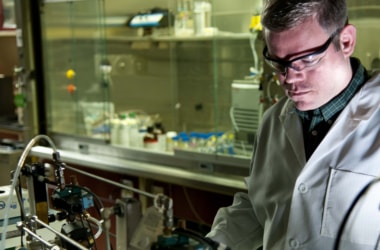 US scientists have discovered a bacteria powered bio battery on a single sheet of paper that can power disposable electronics. US scientists have discovered a bacteria powered bio battery on a single sheet of paper that can power disposable electronics.
Researchers created this new bacteria powered battery and the paper based design is a new field of research called Papertronics which fuses paper and electronics.
Battery is made on a single sheet of paper to power disposable electronics; new and unique manufacturing technology lowers fabrication time and cost.
The design of the battery can revolutionize the use of bio-batteries as a power source in remote, resource limited and dangerous areas.
These self sustained, paper based, point of care devices are vital for providing effective and life saving treatments in resource limited settings.
On one half of a piece of chromatography paper, a ribbon of silver nitrate beneath a thin layer of wax was used to create a cathode.
The reservoir was made out of conductive polymer on the other half of the paper which acted as an anode.
Once folded properly with an addition of a few drops of bacteria filled liquid, the cellular respiration of microbes powers the battery.
Device requires layers to include components such as anode, cathode and PEM (Proton Exchange Membrane).
Different folding methods mean different power and current outputs.
Scientists were able to generate 31.51 Microwatts at 125.53 microamps with 6 batteries in 3 parallel series.
They also generated 44.85 microwatts of power at 105.89 microamps in a 6 by 6 configuration.
Know More About Microwatts
- It is a derived metric SI (System International) measurement unit of power.
- The microwatt is equal to one millionth of a watt (10-6W), a unit of power equal to one millionth of a watt.
- Symbol: µW, µ w.
- Origin of microwatt: 1910-1915
|
▼ World's first biological pacemaker using human stem cells developed [12-27-16]
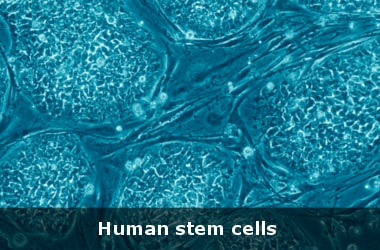 Scientists have developed the first functional pacemaker from human stem cells which can regulate heart beats with electrical impulses, paving the way for alternate, biological pacemaker therapy. Scientists have developed the first functional pacemaker from human stem cells which can regulate heart beats with electrical impulses, paving the way for alternate, biological pacemaker therapy.
These human pacemaker cells were tested in rat hearts and were shown to function as a biological pacemaker, by activating the electrical impulses that trigger the contraction of the heart.
Defects in the pacemaker can lead to heart rhythm disorders that are commonly treated by implantation of electronic pacemaker devices.
Learning how to generate pacemaker cells could help in understanding disorders in pacemaker cells, and provide a cell source for developing a biological pacemaker.
What are Biological Pacemakers?
- Pluripotent stem cells have the potential to differentiate into more than 200 different cell types that make up every tissue and organ in the body.
- Sinoatrial node pacemaker cells are the heart’s primary pacemaker, controlling the heartbeat throughout life.
- Biological pacemakers represent a promising alternative to electronic pacemakers.
- They are crucial for overcoming such drawbacks as a lack of hormonal responsiveness and the inability to adapt to changes in heart size in pediatric patients.
|
▼ Plants can sense gravity: ISS Scientists [12-27-16]
 Scientists have examined cucumber seedlings germinated under microgravity conditions of the International Space Station (ISS), to understand how plants sense gravity and stimulate their own growth. Scientists have examined cucumber seedlings germinated under microgravity conditions of the International Space Station (ISS), to understand how plants sense gravity and stimulate their own growth.
Cucumbers feature specialized protuberances, or pegs, whose formation is regulated by gravity.
These pegs develop during the plant's early growth stage to help the seedlings emerge from their hard seed coat and anchor the developing plant in the soil while its roots form.
When seeds are put before germination either in a vertical position with their embryonic roots pointing down or subjected to microgravity conditions, a peg develops on each side.
However, when they are placed horizontally on the ground, peg formation on the upper side is suppressed in response to gravity.
Scientists also unearthed the valuable contribution of the gravity-sensitive CsPIN1 protein to this process.
The role of the protein in facilitating the transport of the growth hormones had first been suggested in previous experiments conducted on Earth.
Examining cross sections of the cucumber seedlings abroad the space station under a microscope, the scientists found that the CsPIN1 protein can relocalize under the influence of gravity.
The change in the position of protein was found to occur in the transition zone of the cucumber seedling, the area between the stem and the roots, where the pegs develop.
It appears that this behaviour stimulates the formation of a cellular canal capable of transporting growth hormones from one side of this zone to the other, researchers said.
The findings point towards the mechanism by which the seeds are able to turn on and off the growth of their anchoring pegs in relation to their orientation with respect to gravity
|
▼ Ammonia detected in Earth's troposphere for first time [12-27-16]
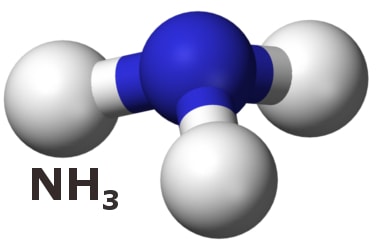 This is the first time scientists have discovered ammonia in the Earth's lowest atmospheric layer. This is the first time scientists have discovered ammonia in the Earth's lowest atmospheric layer.
The highest emissions of the gas encountered in North India and Southeast China.
The satellite measurements by the MIPAS infrared spectrometer found increased amounts of ammonia (NH3) between 12 and 15 km height in the area of the Asian monsoon.
This suggests that the gas is responsible for the formation of aerosols, smallest particles that might contribute to cloud formation, researchers said.
Ammonia is a chemical compound of nitrogen and hydrogen.
It mainly originates from agricultural processes, in particular from life-stock farming and fertilisation.
Highest ammonia emissions are encountered in North India and Southeast China. Due to population growth and global warming, global ammonia emissions are expected to increase strongly in the future, researchers said.
Gaseous ammonia reacts with acids, such as sulfuric acid or nitric acid, to form the corresponding ammonium salts.
Particles of ammonium salts can attach to each other and form aerosol particles acting as condensation nuclei in cloud formation which cool the atmosphere and reverse global warming.
MIPAS recorded highly resolved spectra in the middle infrared range, from which gases can be identified clearly. Every gas emits specific infrared radiation.
Ammonia
- Formula: NH3
- IUPAC ID: Azane
- Molar mass: 17.031 g/mol
- Boiling point: -33.34 °C
- Density: 0.73 kg/m³
- Melting point: -77.73 °C
|
▼ Benthic Rover - Autonomous seafloor crawler completes longest distance, duration under sea [12-27-16]
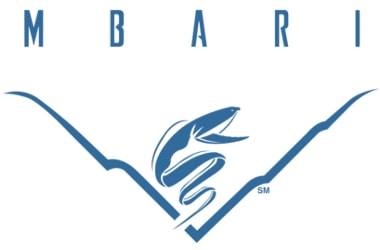 An autonomous robotic seafloor crawler has set a new world record for the longest distance travelled and duration sustained under the sea, while collecting climate data for an entire year. An autonomous robotic seafloor crawler has set a new world record for the longest distance travelled and duration sustained under the sea, while collecting climate data for an entire year.
Benthic Rover, developed by the Monterey Bay Aquarium Research Institute (MBARI) in the US, is the only untethered, entirely autonomous seafloor crawler currently.
The Rover operates at Station M, an area of flat seafloor 4,000 meters deep and about 220 kilometres from the California coastline.
One of the most significant findings from the last few years of the Rover's deployments involved several large pulses of marine snow that rapidly sank to the seafloor.
These pulses may be related to stronger along-shore winds that drive the upwelling of nutrients in coastal waters.
The nutrients spur the growth of phytoplankton and zooplankton, which increases the amount of marine snow that rains down to the seafloor.
Organisms in this abyssal realm rely upon marine snow as their primary source of food. The Benthic Rover records how much of the marine snow is consumed by the seafloor community.
Value of the Benthic Rover
- The Rover detected several brief, two- to four-week events.
- This was when nearly an entire year's worth of chlorophyll-rich detritus landed on the seafloor.
- These events would have gone undetected without the Benthic Rover.
- Rover helped solve an important piece of Earth's carbon-cycle puzzle.
- It was critical in showing that a much larger percentage of carbon than previously expected can sink rapidly from the surface into deeper water.
- These periodic events can now be factored into global climate change models.
|
▼ Smart Consumer - Govt. Mobile app for speedy redressal of consumer issues [12-27-16]
 The Union Government on 24 Dec 2016 launched ‘Smart Consumer’ mobile App to provide speedy redressal of consumer grievances. The Union Government on 24 Dec 2016 launched ‘Smart Consumer’ mobile App to provide speedy redressal of consumer grievances.
Besides, the government also launched an Online Consumer Mediation Centre (OCMC) and a helpline number 14404 for redressal of consumer related grievances. These initiatives will benefit the consumers in the digital world.
The government also launched a microsite based on the theme 'Digitally Safe Consumer Campaign' to help consumers for being vigilant and not falling prey to cyber frauds.
Launches were made on the occasion of National Consumer Day that is observed on 24 December every year.
OCMC is launched in association with Bengaluru's NLSIU to provide quick redressal of consumer grievances.
It will allow consumers and companies to go for pre-litigation and provide for harmonious settlement of dispute.
The mediation centre will only deal with cases associated with e-commerce companies.
It will facilitate online and physical mediation between consumers and companies.
'Digitally Safe Consumer Campaign'
- The campaign will be launched in January 2017 by Google India in partnership with the Union Ministry of Consumer Affairs.
- This yearly campaign will be focussed on building capacities of consumer organisations and counsellors on internet safety and related issues.
- The campaign will reach out to over 1200 consumer organisations as well as consumer affairs department of every state across the country.
- Google will also work towards advocating digital security and privacy needs through workshops training about 500 people.
|
▼ Hafnium carbide: A material which can withstand 4,000 degrees F [12-26-16]
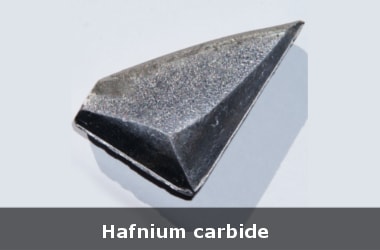 Scientists have identified materials that can withstand temperatures of nearly 4,000 degree C, an advance that has paid the way for heat resistant shielding for the faster than ever hypersonic space vehicles. Scientists have identified materials that can withstand temperatures of nearly 4,000 degree C, an advance that has paid the way for heat resistant shielding for the faster than ever hypersonic space vehicles.
Researchers from Imperial College London in the UK discovered that the melting point of hafnium carbide is the highest ever recorded for a material.
Tantalum carbide (TaC) and Hafnium Carbide (HfC) are refractory ceramics, meaning they are extraordinarily resistant to heat.
Their ability to withstand extremely harsh environments means that these could be used in thermal protection systems on high-speed vehicles and as fuel cladding in the super-heated environments of nuclear reactors.
What was lacking till now was technology to test the melting point of TaC and HfC in the lab to determine how truly extreme an environment they could function in.
The researchers developed a new extreme heating technique using lasers to test the heat tolerance of TaC and HfC.
They used the laser-heating techniques to find the point at which TaC and HfC melted, both separately and as mixed compositions of both.
They found that the mixed compound (Ta0.8Hf0.20C) was consistent with previous research, melting at 3,905 degrees Celsius, but the two compounds on their own exceeded previous recorded melting points.
The compound TaC melted at 3,768 degrees Celsius, and HfC melted at 3,958 degrees Celsius.
Spacecrafts could become faster than ever with the next generation of hypersonic vehicles. Friction involved while travelling above Mach 5 hypersonic speeds creates high temperature. Hafnium carbide can withstand such heat.
These materials may enable spacecraft to withstand the extreme heat generated from leaving and re-entering the atmosphere.
Hafnium Carbide
- Formula: HfC
- Molar mass: 190.5 g/mol
- Melting point: 3,900°C
- Density: 12.2 g/cm³
- Appearance: Black odourless powder
|
▼ India’s first private mission to the moon to make space exploration history [12-26-16]
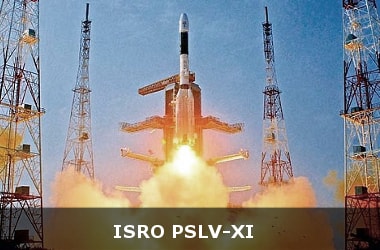 When ISRO's Polar Satellite Launch Vehicle-Xl (PSLV-X1) lifts off around December 28, 2017, with India's first private mission to the moon by Team Indus, it promises to be a historical event. When ISRO's Polar Satellite Launch Vehicle-Xl (PSLV-X1) lifts off around December 28, 2017, with India's first private mission to the moon by Team Indus, it promises to be a historical event.
It is for the first time in the history of space exploration that a rocket will be flying three rovers.
Of the three rovers in this private moon mission, two are from Japan and one belongs to Team Indus.
The PSLV-XL has launched 20 satellites in one go on June 22, 2016.
This marks the first time the PSLV will demonstrate the capability of carrying three rovers placed into a lander.
The powerful rocket will launch 83 satellites in a single mission.
According to the organisers of the global lunar competition, Google Lunar X Prize, "the Japanese Team, Hakuto, is facing the challenges with its unique dual rover system consisting of the two-wheeled 'Tetris,' and the four-wheeled 'Moonraker', which are linked by a tether".
The organisers added that while Tetris will explore holes thought to be caves in the moon, Moonraker will capture 360-degree images.
Team Indus's new-look sleek rover is solar-powered and the mission duration is one lunar day - equivalent to 14 earth days.
The Team Indus lander can carry up to 20kg of payload at a time.
PSLV
- The PSLV is one of world's most reliable launch vehicles.
- It has been in service for over twenty years.
- PSLV remains a favourite among various organisations as a launch service provider and has launched over 40 satellites for 19 countries.
- In 2008 it created a record for most number of satellites placed in orbit in one launch by launching 10 satellites into various Low Earth Orbits.
It has launched various satellites for historic missions like
- Chandrayaan-1
- Mars Orbiter Mission
- Space Capsule Recovery Experiment
- Indian Regional Navigation Satellite System (IRNSS)
|
▼ Vela supercluster: Huge mass influencing galaxy motion [12-23-16]
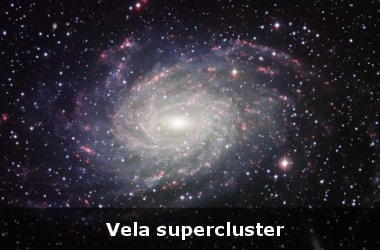 An international team of astronomers has found one of the universe's biggest superclusters of galaxies near the Milky Way. An international team of astronomers has found one of the universe's biggest superclusters of galaxies near the Milky Way.
Researchers said the Vela supercluster, which had previously gone undetected as it was hidden by stars and dust in the Milky Way, was a huge mass that influenced the motion of our galaxy.
The gravity of the Vela supercluster may explain the difference between the measured motion of the Milky Way through space and the motion predicted from the distribution of previously mapped galaxies.
Anglo-Australian Telescope was used to measure distances for many galaxies to confirm earlier predictions that Vela was a supercluster.
|
▼ TanSat: China’s answer to rising Carbon dioxide and fog [12-23-16]
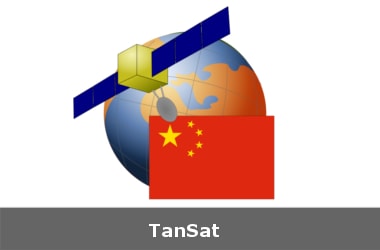 On 22nd Dec 2016, China launched a global carbon dioxide monitoring satellite to understand climate change. On 22nd Dec 2016, China launched a global carbon dioxide monitoring satellite to understand climate change.
This is after it lifted nearly a week-long red alert for the worst smog that engulfed about 40 cities in the country.
The 620-kg satellite TanSat was put into orbit by Long March-2D rocket from Jiuquan Satellite Launch Centre in northwest China's Gobi Desert on 22nd Dec morning.
This was the 243rd mission of the Long March series rockets.
Besides TanSat, the rocket also carried a high-resolution micro-nano satellite and two spectrum micro-nano satellites for agricultural and forestry monitoring.
China is the third country after Japan and the US to monitor greenhouse gases through its own satellite.
The satellite was sent into a sun synchronous orbit about 700 kms above the earth and will monitor the concentration, distribution and flow of CO2)in the atmosphere.
The satellite will help understanding climate change and provide China's policy makers with independent data.
On a three-year mission, TanSat will thoroughly examine global carbon dioxide levels every 16 days, accurate to at least 4 ppm (parts per million), the report said.
The new satellite will enable China to obtain emissions data first-hand and share it with researchers worldwide, Yin said.
The satellite can trace the sources of greenhouse gases and help evaluate whether countries are fulfilling their commitments.
This will impact climate change, carbon reduction and in negotiations with a bigger say on carbon trading.
Beijing lifted the red alert for air pollution as cold air dispersed the smog that has affected the city since Dec 17 which drew strong criticism from public as it disrupted the normal life.
Since December 17 emergency measures such as even-odd car restrictions will end and classes will resume at schools, official media reports said.
China's CO2 emissions are to peak around 2030, with emissions per unit of GDP cut by 60 per cent of 2005 levels by the same date.
TanSat
- TanSat, Tan being the Chinese word for Carbon, is China’s first mission dedicated to Carbon Dioxide detection.
- It has a payload of two instruments to track the atmospheric CO2 concentration and variability.
- Funded by the Ministry of Science and Technology, the TanSat project was initiated in January 2011.
- The 500-Kilogram TanSat spacecraft has the main objective of measuring the atmospheric column-averaged CO2 dry air mole fraction with a precision better than four parts per million.
|
▼ NASA space based sensors first continuous look at phyotplanktons [12-23-16]
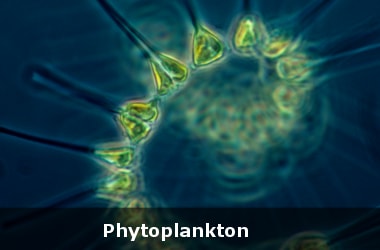 NASA space-based sensor that can 'see' through fog, clouds and darkness has given scientists the first continuous look at the boom-bust cycles of polar phytoplanktons, microscopic marine plants NASA space-based sensor that can 'see' through fog, clouds and darkness has given scientists the first continuous look at the boom-bust cycles of polar phytoplanktons, microscopic marine plants
Phytoplanktons are the foundation of the ocean's food web.
The decade-long set of images shows that phytoplankton cycles are more tied to the push-pull relationship between them and their predators than was initially thought.
Commercial fisheries, marine mammals and birds all depend on the phytoplankton.
Phytoplankton also influences Earth's carbon cycle. Through photosynthesis, they absorb a great deal of the carbon dioxide near the ocean's surface. That, in turn, allows CO2 from the atmosphere to go into the ocean.
Satellite-mounted LIDAR instrument, dubbed Cloud-Aerosol Lidar with Orthogonal Polarisation (CALIOP), uses a laser beam to map the ocean's surface and immediate subsurface.
CALIOP monitored plankton in the Arctic and Antarctic ocean waters from 2006-2015
Its measurements show that, as the phytoplankton growth accelerates, the blooms are able to outpace the organisms that prey on them.
Once that acceleration stops, however, the predatory organisms catch up and the bloom ends.
The finding goes against the commonly held belief that blooms begin when phytoplankton growth rates reach a threshold rate and then stop when growth rates crash.
Instead, blooms start when growth rates are extremely slow, and then stop when phytoplankton growth is at its maximum but the acceleration of the bloom has hit its peak.
It is only at this point that the predatory organisms catch up and the bloom terminates.
Study showed in Arctic waters the year-to-year changes in this constant push and pull between predator and prey has been the primary driver of change over the past decade.
It is different in the southern ocean around Antarctica, where changes in the ice cover held more sway.
|
▼ Ooty becomes 100th rail station to get Railwire Wi-Fi from Google [12-23-16]
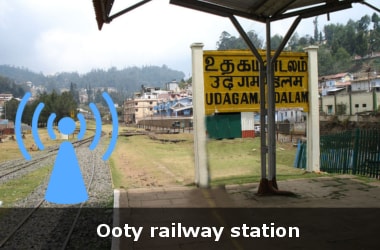 Google, in partnership with Indian railways RailTel on 22nd Dec 2016 launched Railwire Wi-Fi at Udhagamandalam (Ooty). Google, in partnership with Indian railways RailTel on 22nd Dec 2016 launched Railwire Wi-Fi at Udhagamandalam (Ooty).
With this it succeed in fulfilling the commitment to bring high-speed Internet to 100 railway stations by the end of 2016.
With over 5 million monthly users, the Google-Railtel Wi-Fi is helping millions of Indians discover the benefits of Internet with 15,000 first time users connecting to the network every day.
Nearly 1 crore passengers who pass through these stations every day have an access to the free Internet.
The users need to select Railwire as a preferred Wi-Fi network and enter a four-digit OTP (one-time password) to access data services.
The initiative launched in January this year, Google said, will continue to deploy the Wi-Fi at next 300 stations over a period of a couple of years.
Google
- CEO: Sundar Pichai (Since 2015)
- Founded: September 4, 1998, Menlo Park, California, United States
- Revenue: 74.54 billion USD
- Subsidiaries: YouTube, Nik Software, AdMob, ITA Software
- Founders: Larry Page, Sergey Brin
RailTel
- Native name: रेलटेल कॉर्पोरेशनऑफ़इंडियालिमिटेड
- Type: Public sector undertaking (PSU)
- Industry: Telecommunications
- Founded: September 2000;
- Headquarters: 143, Institutional Area, Sector-44, Gurgaon, Haryana, India
- R.K. Bahuguna (Chairman & MD)
- Services: RailTel Services, Carrier Service-Leased Line, NLD for Voice Carriage, Managed Co locations Enterprise Service (MPLS-VPN), Internet
|
▼ New web portal Coal Mitra launched [12-22-16]
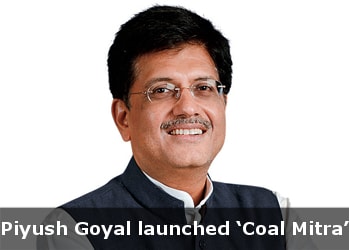 Union Minister of State (IC) for Power, Coal, New & Renewable Energy and Mines, Shri Piyush Goyal launched ‘Coal Mitra’, a Web portal for flexibility in Utilization of Domestic Coal and released reports on ‘Renewable Energy Integration: Transmission an Enabler’, ‘Green Energy Corridor II’ and ‘Electricity Demand Pattern Analysis’ on 21st Dec. Union Minister of State (IC) for Power, Coal, New & Renewable Energy and Mines, Shri Piyush Goyal launched ‘Coal Mitra’, a Web portal for flexibility in Utilization of Domestic Coal and released reports on ‘Renewable Energy Integration: Transmission an Enabler’, ‘Green Energy Corridor II’ and ‘Electricity Demand Pattern Analysis’ on 21st Dec.
The Coal Mitra Web Portal has been designed to bring about flexibility in Utilisation of Domestic Coal by transferring the reserves to more cost efficient State/Centre owned or Private sector generating stations.
It will be leading to lower generation costs and ultimately lesser cost of electricity for the consumers.
The web portal would be used by the State/Central Gen Cost to display information about normative fixed and variable charges of electricity for the previous month as well as margin available for additional generation so as to enable the utilities identify stations for transfer of coal.
It would host data on Operational and Financial parameters of each coal based station; Quantity and source of supply coal to the power plant; and Distance of Power plant from the Coal mine.
Reports released include ‘Renewable Energy Integration: Transmission, an Enabler’, ‘Green Energy Corridors - II’ and ‘Electricity Demand Pattern Analysis’.
The first two reports, prepared by PGCIL, cover aspects of comprehensive transmission plan to integrate renewable energy sources into the National Grid and role of Transmission as an Enabler in growing Renewable Energy (RE) penetration scenario.
The last report has been prepared by Power System Operation Corporation Limited (POSOCO).
About Coal Reports
The ‘Renewable Energy Integration: Transmission, an Enabler’ report :
- Covers the study of balancing and stability issues for 15% & 30% RE capacity penetration.
- Also studies the aspects of Balancing Reserve Analysis with Thermal Power Plants, both gas and supercritical coal, Reservoir type Hydro & Pumped Storage Plants
The ‘Green Energy Corridors-II’ (Part-A) report:
- Details about the identified capacity of Solar Parks and transmission infrastructure requirement in various states at Intra-State and Inter-state level.
- Inter-alia covers the financing options available for rationalisation of transmission tariff.
- Covers challenges to be addressed to facilitate smooth integration of solar power parks.
The ‘Electricity Demand Pattern Analysis’ report:
- Covers the analysis of data archived by POSOCO since 2008 with insights towards diurnal, seasonal and yearly demand patterns, decomposition of demand data into seasonal trends at all levels - National, regional and individual State level.
|
▼ Meet FlockOS - World’s first chat operating system [12-21-16]
 Flock, a team messenger for businesses, on 20th Dec 2016 launched world's first chat operating system "FlockOS" which allows developers to build customised apps, bots and integrations on Flock. Flock, a team messenger for businesses, on 20th Dec 2016 launched world's first chat operating system "FlockOS" which allows developers to build customised apps, bots and integrations on Flock.
Developers can either use the customised apps within their organisations or publish it on Flock's App Store, making them available for all Flock users.
The User Interface (UI) is a canvas for developers, allowing them to create truly intuitive apps and integrations which seamlessly blend with the core product
Bhavin Turakhia is currently the CEO, Flock.
Chat will soon become the next operating system, probably within the next three to five years.
With "FlockOS", developers can build apps that provide a tightly integrated experience by using widgets. These include the attachment widget, sidebar widget and modal widget.
"FlockOS" provides setup slash commands, providing an additional option for users to interact with the app and can configure a Bot to send directed messages to users, initiating conversations and completing tasks from within Flock.
|
▼ Scientists discover huge dead zone in Bay of Bengal [12-21-16]
 Researchers have discovered a huge dead zone in the Bay of Bengal. The area, estimated at 60,000 square km, reported to contain little or no oxygen. Researchers have discovered a huge dead zone in the Bay of Bengal. The area, estimated at 60,000 square km, reported to contain little or no oxygen.
The area is hosting microorganisms which remove a large amount of nitrogen from the ocean.
Though dead zones were found in other oceanic bodies as well, this also marks the first time there is indication of nitrogen loss.
Researchers from the CSIR National Institute of Oceanography reported though some amount of oxygen does exist in the Bay of Bengal, the concentrations are lesser than could be detected by standard techniques.
Oxygen levels are stated to be around 10000 times lesser than the amount discovered in air saturated surface waters.
Microbes present in the Bay of Bengal were capable of removing the nitrogen from the water, but traces of oxygen stop them from doing so.
Though there is some evidence of nitrogen removing microorganisms exist in well known dead zones as well, they are reported to work at a slower, more gradual rate.
Wajih Naqvi, the former director of the National Institute of Oceanography said that if the last amount of oxygen is removed from the ocean, then the bay would become the cause of nitrogen removal from oceans across the world.
Complete removal of nitrogen could affect the nitrogen balance in marine life and the rate of their productivity.
Dead zones are created when excess nutrients (nitrogen and phosphorous) result in the overgrowth of algae which later decomposes in the water consuming excess oxygen, lowering the supply available to marine life.
Global warming triggered by climate change will expand the dead zones.
It is not clear whether climate change would lead to removal of all oxygen from the bay.
What Are Dead Zones?
- Large areas in the ocean with low oxygen concentration(hypoxic) in the lower part.
- Marine life in such areas suffocates and dies or moves away.
- Dead zones can occur due to natural or manmade reasons.
- Main cause of zones created by humans is nutrient pollution.
Other dead zones:
- Baltic sea bottom.
- Gulf of Mexico
- North, South America west coasts
- Namibia coast
- Indian western coast
|
▼ Harvard University researchers create world’s smallest radio receiver [12-20-16]
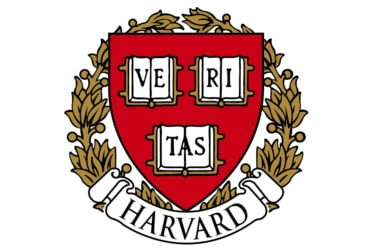 Researchers at Harvard University have created the world's smallest radio receiver which is made from diamonds. Researchers at Harvard University have created the world's smallest radio receiver which is made from diamonds.
The radio receiver is based on nano-sized flaws in the pink diamond. Its functional building blocks are the size of only two atoms.
The world's smallest radio receiver works perfectly for playing music on a local radio station. It's a device built on a micro-scale
Human created radio transmissions were established in the 19th century.
In addition to its small dimensions, the pink diamond basis of the receiver means that this piece of nanotechnology is highly resistant to external conditions.
This is making future versions of the device ideal for use in space or other extreme environments.
The technology at the core of the receiver might also be used in quantum computing, potentially pushing future computer processing power forward by a massive margin.
The scientists could remove one carbon atom in the diamond and replace it with a nitrogen atom. Next to the nitrogen atom, the scientists removed another carbon atom.
Thereby they set up an atomic-scale system consisting of a nitrogen atom with a hole next to it (thus, "nitrogen-vacancy"). These NV centers were each able to emit single photons and detect magnetic fields.
The scientists then pumped green laser light into the diamond, exciting the electrons in the NV centers.
Once excited, these electrons are able to detect electromagnetic fields, including radio waves, and convert these signals into red light.
From there, a photodiode could read the red light and convert it into a current, which was then translated into sound.
A strong magnetic field around the diamonds allowed scientists to tune the device by changing the receiving frequency of the NV centers.
|
▼ Everyone has only brown eyes in a real sense! [12-19-16]
 Everyone has brown eyes and there are no blue or green colour eyes in real sense, a scientist has said. Everyone has brown eyes and there are no blue or green colour eyes in real sense, a scientist has said.
There is only one pigment for eye colour viz. brown. Eye colours like blue, green, hazel, etc are what people might call an optical illusion.
Pigments in our body are determined by something call melanin.
Irises are made up of a miniature version of melanin called melanocytes, which only come in one colour– brown.
Even though all eyes are technically brown, the amount of melanocytes varies from person to person. However, people with lighter eyes have less melanocytes allowing light to be more easily absorbed and reflected, making their eyes appear lighter in colour.
Brown-eyed people have more melanin, less light. The opposite is true for people with "blue" eyes.
Those with less melanocytes cannot absorb as much light, so more light is reflected back out of the eye. This is called scattering and when light is scattered, it reflects back at shorter wavelengths.
On the colour spectrum, shorter light wavelengths correspond with the colour blue.
|
▼ 2 billion year old water found in Canada! [12-19-16]
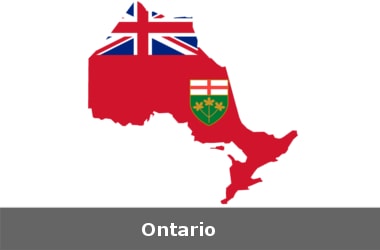 Scientists have stumbled across water dating back to 2 billion years, as Canadian scientists uncovered what seems to be the oldest water discovered on planet Earth, which they say could open new doors in order to gain an insight into how life emerged on our planet – and possibly elsewhere. Scientists have stumbled across water dating back to 2 billion years, as Canadian scientists uncovered what seems to be the oldest water discovered on planet Earth, which they say could open new doors in order to gain an insight into how life emerged on our planet – and possibly elsewhere.
Located in Timmins, Ontario, researchers from the University of Toronto found the primordial water at a depth of 2.4 km in Kidd Creek Mine.
The same team of researchers, co-headed by geoscientist Oliver Warr discovered 1.5 billion-year-old water in the same active copper, zinc, and silver mine, but at a shallower depth, 3 years before.
The earth was 2.5 billion years old when this water got collected. Also, the volume of the water is much larger than anyone anticipated.
Traces of helium, argon, neon, krypton, and xenon were found after a chemical analysis of the water was conducted.
Gases accumulate in the water over time, allowing the researchers to calculate its age. The water also contains trace metals and salt (about eight times the amount found in seawater).
The researchers describe the water as an interconnected fluid system deep in the Canadian Shield that’s billions of years old and capable of supporting life.
Further analysis could reveal the state of the Earth’s atmosphere two billion years ago.
The ancient water could also shed light on earlier life that existed during the time.
|
▼ Neutron stars can generate gravity waves! [12-19-16]
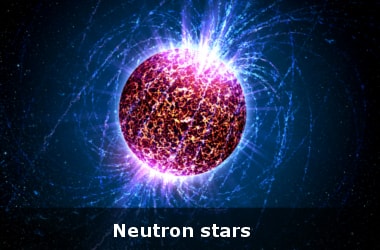 Months after the discovery of gravitational waves created by the merger of two black holes, scientists from the Tata Institute of Fundamental Research (TIFR), Mumbai, and Massachusetts Institute of Technology (MIT) have identified another celestial object that could be generating gravitational waves namely the neutron star. Months after the discovery of gravitational waves created by the merger of two black holes, scientists from the Tata Institute of Fundamental Research (TIFR), Mumbai, and Massachusetts Institute of Technology (MIT) have identified another celestial object that could be generating gravitational waves namely the neutron star.
Scientists say there is strong indication that a population of neutron stars can generate continuous gravitational waves, making their detection possible.
Neutron stars, created by the death of a giant star, are the densest observable objects in the universe, with a star of a city’s size, having a mass about 1.4 times that of the sun.
The finding comes 10 months after the discovery of gravitational waves created by the merger of two black holes, different by 7 times the mass of the Sun.
As gravitational waves are not absorbed or reflected by matter, they carry information on the motion of objects as stars and planets in the universe. This helps understand the creation of the universe and its history.
In the 1970s it was believed there was no chance of this.
Previously, gravitational waves were found only from black hole mergers.
What are Gravitational Waves?
- Albert Einstein first predicted gravitational waves in 1916.
- Laser Interferometer Gravitational-Wave Observatory (LIGO) Scientific Collaboration of 1,006 members from 15 countries announced the discovery of gravitational waves in February, 2016.
- Created by massive movements in the universe, such as:
- Two black holes colliding,
- Massive stars exploding, or
- The Birth of the Universe some 13.8 billion years ago
|
▼ China launches satellite ground station at North Pole [12-19-16]
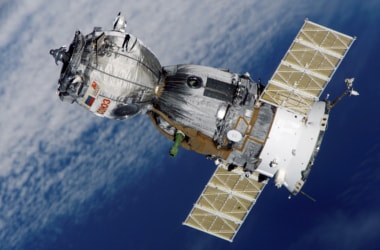 China has launched its first fully- owned overseas satellite ground station near the North Pole. China has launched its first fully- owned overseas satellite ground station near the North Pole.
This could enable Beijing to collect satellite data anywhere on the Earth at a speed it said was the fastest in the world.
The facility, located in Sweden about 200 kms north of the Arctic Circle, would allow China to collect satellite data anywhere on Earth at speeds that were more than twice as fast as before, said the Chinese Academy of Sciences, the academic governing body that built and runs the station.
The new facility would play an important role in China's Gaofen project - a network of observation satellites orbiting the Earth to provide global surveillance capabilities - which was due to be completed in 2020.
Domestic ground stations have needed up to seven hours to download the data from satellites orbiting the Earth in the past, but with the facility in Sweden, the maximum delay for downloading data would be less than 3.5 hours.
The shorter time is because the mapping, weather, reconnaissance and military satellites orbiting the North Pole are able to pass around the Earth about 12 times each day, while those flying over China can orbit the Earth only about five times each day.
The academy said the Arctic station would be using the best and most sensitive signal receiving devices China had ever built, including one with higher bandwidth, covering frequencies from 26.5 to 40 GHz, which had a download speed of 6 Gigabits (billions of bits) per second.
China has previously built ground satellite facilities in numerous foreign countries, mostly in Africa and South America, which are all joint ventures, the report said.
|
▼ USICEF initiative launched with US-India push for clean energy [12-19-16]
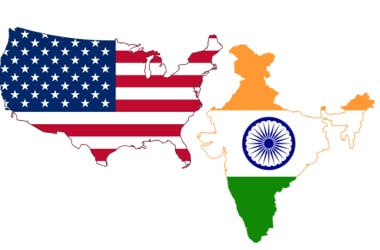 Shri Piyush Goyal Minister of State (IC) for Power, Coal & New and Renewable Energy and Mines and US Ambassador Mr Richard Verma in India launched new joint initiative of US-India Clean Energy Finance (USICEF) Initiative. Shri Piyush Goyal Minister of State (IC) for Power, Coal & New and Renewable Energy and Mines and US Ambassador Mr Richard Verma in India launched new joint initiative of US-India Clean Energy Finance (USICEF) Initiative.
This would help in unlocking OPIC financing and mobilise public and private capital to expand access to distributed clean energy projects on 17th Dec 2016.
Letter of Intents were signed and exchanged for creation of a $20 million for US-India Clean Energy Finance (USICEF) Initiative, equally supported by the United States and India would support projects which, upon long-term financing and deployment, and would qualify for the support of long-term debt financing from OPIC.
The U.S.-India Clean Energy Finance facility (“USICEF”) would support project preparation activities for distributed solar projects in order to unlock OPIC financing and mobilise public and private capital to expand access to distributed clean energy solutions that will benefit disadvantaged communities in India and contribute to India’s ambitious renewable energy and energy access goals.
USICEF builds on the success of other project preparation facilities to support renewable energy in emerging markets.
Through this initiative, project developers pursuing mini-grid, distributed rooftop and off-grid solar projects, as well as smaller-scale grid connected solar projects would be benefitted.
|
▼ Government to launch AEPS mobile app [12-19-16]
 Government will launch a mobile app to facilitate Aadhaar linked digital payments and roll out a nationwide program to train one crore people on e-payments. Government will launch a mobile app to facilitate Aadhaar linked digital payments and roll out a nationwide program to train one crore people on e-payments.
The AEPS or Aadhaar enabled payment system will be promoted to enable coordination with the Finance Ministry.
Around 40 crore bank accounts have been linked to Aadhaar. Biometric devices can be connected to smartphones and convert it into PoS machine. A UPI enabled mobile application will be available in 2-4 days.
Customer feed Aadhaar number, scan figure on the biometric and approval of the amount paid on the application will be involved and the payment will be transferred from the account to the merchant’s account.
Customers will not need to share bank account details as the application will detect the bank account linked to the Aadhaar number with the aid of UPI or Unified Payment Interface.
Common Service Centres across the country are carrying out AEPS transactions and the same will now be available through mobile app.
Government will also train 14 lakh VLEs cross 500 districts and 6500 blocks carrying out digital transactions.
As per the programme, each VLE will train 40 individuals covering 80 lakh individuals and at least 10 shopkeepers will target total cover of 25 merchants across the nation.
Even migrant workers having Aadhaar will be able to open bank accounts.
Aadhaar Card
- 12 digit unique identity number.
- Issued by: Unique Identification Authority of India.
- Central government agency UIDAI has launched this project.
- It is considered the world’s largest national identification number project.
- This card serves as proof of identity and address anywhere in India.
- Enrolment is free of cost and needs to be done voluntarily.
|
▼ Honeycomb like metal structure MOFs for capturing harmful gases invented [12-15-16]
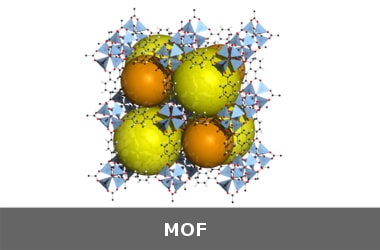 Scientists have developed a new method that can trap potentially harmful gases emitted by coal factories, cars and trucks within honeycomb-like microscopic organo-metallic structures. Scientists have developed a new method that can trap potentially harmful gases emitted by coal factories, cars and trucks within honeycomb-like microscopic organo-metallic structures.
These Metal-organic frameworks (MOFs), comprise different building blocks composed of metal ion centres and organic linker molecules.
Altogether they form a honeycomb-like structure that can trap gases within each comb, or pore.
The small nano-scale structures also have the potential to trap various emissions from things as immense as coal factories and as small as cars and trucks.
Scientists decided to use a molecule that can cap the outer surface of each of Metal-organic frameworks (MOFs) crystal in the same way bees seal their honeycombs with wax to prevent honey from spilling out and it worked.
|
▼ NASSCOM, DSCI release cybersecurity roadmap for next 10 years [12-15-16]
 In an effort to make India a global hub for cyber security-related requirements, the IT industry's representative body Nasscom and the Data Security Council of India (DSCI) on 14th Dec launched a comprehensive roadmap for the next decade. In an effort to make India a global hub for cyber security-related requirements, the IT industry's representative body Nasscom and the Data Security Council of India (DSCI) on 14th Dec launched a comprehensive roadmap for the next decade.
Entitled "Growing Cyber Security Industry, Roadmap for India," the report identifies Managed Security Service (MSS), Security and Vulnerability Management (SVM) and network security emerging as important opportunities globally.
MSS emerges the most attractive opportunity, with the highest growth of (more than 12 per cent) and largest market size ($18 billion).
16 initiatives has been formulated by Nasscom-DSCI. Effective programme roll-out and strategic vision realisation will require disciplined management of the 16 key initiatives suggested by the report,”
Indian IT Industry & Cybersecurity
- Indian IT industry is set to reach a size of $350-$400 billion by 2025 (NASSCOM).
- The cyber security product and services industry of $35 billion by 2025 will generate a skilled workforce of one million in the security sector with cyber security products constituting a $38 billion market in 2015.
- In 2015, Nasscom-DSCI established the Cyber Security Task Force (CSTF) initiative.
- This aims to create by 2025:
a. One million cyber security jobs and
b. 1,000 cyber security startups
|
▼ Now, US Department of Transportation proposes cars should "talk" to each other! [12-15-16]
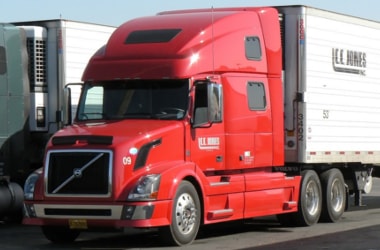 The US Transportation Department on 13th Dec 2016 proposed requiring all new cars and trucks to be able to "talk" to one another using short-range wireless technology to potentially avoid crashes. The US Transportation Department on 13th Dec 2016 proposed requiring all new cars and trucks to be able to "talk" to one another using short-range wireless technology to potentially avoid crashes.
Regulators, which first announced plans to pursue requiring the technology in early 2014, are proposing to give automakers at least four years to comply from the time it is finalised.
They would require automakers to ensure all vehicles "speak the same language through a standard technology.”
The administration of President-elect Donald Trump will decide whether to finalise the proposal, which does not apply to larger vehicles like buses and tractor trailers.
The U.S. National Highway Traffic Safety Administration (NHTSA) estimates that talking vehicles could eliminate or reduce the severity of up to 80 percent of crashes where alcohol is not a factor, especially crashes at intersections or while changing lanes.
Last year, there were 6.3 million US vehicle crashes.
Talking cars and trucks would use dedicated short range communications to transmit data up to 300 meters, such as location, direction and speed, to nearby vehicles.
That data would be updated and broadcast up to 10 times per second to nearby vehicles, which can identify risks and provide warnings to drivers to avoid imminent crashes.
The rule would not require vehicles currently on U.S. roads to be retrofitted with the technology.
Federal Highway Administration plans to issue guidance for vehicle-to-infrastructure communications, which will help planners allow vehicles to "talk" to roadway infrastructure such as traffic lights.
|
▼ Facebook launches Parent Portal [12-14-16]
 To empower parents help their child navigate safely on Facebook, the social networking giant on 13th Dec 2016 announced Parent's Portal in collaboration with parents, teenagers and safety experts around the world. To empower parents help their child navigate safely on Facebook, the social networking giant on 13th Dec 2016 announced Parent's Portal in collaboration with parents, teenagers and safety experts around the world.
Facebook updated its Safety Centre and Bullying Prevention Hub and has now introduced Parent's Portal, which provides parent specific advice as part of the Safety Centre.
Parent's Portal comprises guides for parents about how Facebook works, tips for talking with kids about staying safe online and resources from experts around the world.
It is present in over 55 languages, including 11 in India, is mobile friendly and includes step-by-step videos.
With the new Safety Centre and Parent's Portal, we worked with safety experts and local partners to develop content that resonates within India.
|
▼ Newborn planets orbiting star found [12-14-16]
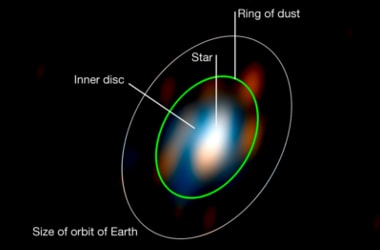 Astronomers believe they have found two newborn planets, each about the size of Saturn, orbiting around a young star known as HD 163296. Astronomers believe they have found two newborn planets, each about the size of Saturn, orbiting around a young star known as HD 163296.
These planets, which are not yet formed fully, revealed themselves by the dual imprint they left in both the dust and the gas portions of the star's protoplanetary disk, the scientists said.
Studying HD 163296, the research team used Atacama Large Millimetre/submillimetre Array (ALMA) to trace, for the first time, the distribution of both the dust and the carbon monoxide (CO) gas components of the disk.
The new observations provide evidence that planets are indeed forming around this one young star.
HD 163296 is around five million years old and about twice the mass of the Sun. It is located approximately 400 light years from Earth in the direction of the constellation Sagittarius.
The researchers found three distinct gaps in the star's dust-filled protoplanetary disk.
By observing the same features in both the gas and the dust components of the disk, the astronomers believe they have found compelling evidence that there are two planets coalescing remarkably far from the central star.
Width and depth of the two carbon monoxide gaps suggest that each potential planet is roughly the same mass as Saturn.
|
▼ ISRO signs agreement with 6 companies, to deliver India’s first industry built satellite [12-14-16]
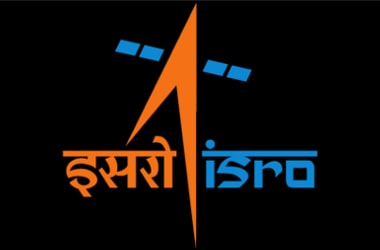 The Indian Space Research Organisation in Dec 2016 signed an agreement with a consortium of six companies to deliver India's first industry-built satellite by late 2017. The Indian Space Research Organisation in Dec 2016 signed an agreement with a consortium of six companies to deliver India's first industry-built satellite by late 2017.
Agreement was signed between Director of ISRO Satellite Centre and consortium led Alpha Design Technologies Pvt. Ltd.
This marks the first time ISRO has outsourced the construction of an entire satellite.
ISAC assembles satellites for communication, remote sensing and navigation.
Agreement includes assembly, integration and testing (AIT) of two spare navigation satellites in a row in around 18 months.
The consortium is led by Alpha Design Technologies Pvt. Ltd, a defence manufacturing contractor and 6 companies namely Newtech Solutions, Aidin Technologies and DCX Cables of Bengaluru, Vinyas Technologies of Mysuru and Avantel Systems of Hyderabad.
The development work will start around January 2017 and the first satellite will be out in around late 2017.
The outsourcing of the manufacture of 2 navigation satellites will provide India a chance to be a market leader in space technology.
ISRO also aims to facilitate greater participation of Indian industries.
For this purpose, it has already passed on 300 technologies to industries in various fields- electronics, speciality polymer chemicals and materials, electro-optical instruments etc.
|
▼ Now, scientists build safer nuclear reactors with Nanoceramic material [12-13-16]
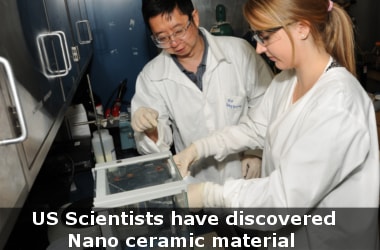 A team of scientists from the United States have created a Nanoceramic material that can be used to produce safer and economical nuclear reactors. A team of scientists from the United States have created a Nanoceramic material that can be used to produce safer and economical nuclear reactors.
The team included Fabio Di Fonzo and Kumar Sridharan and others.
The research was published in the Nature journal Scientific Reports in September 2016 with the title “Radiation endurance in Al2O3 nanoceramics.”
Earlier water was used as the primary coolant in reactors for absorbing the heat released from fission reactions which poses risks of corrosion damage to materials.
It also limits the temperatures up to which water-cooled reactors can operate because of which it cannot be used in advanced reactors.
About Nanoceramic material
- Made of: aluminium oxide nanoceramic coating.
- Can withstand harsh temperatures and radiation.
- It becomes tougher under radiation.
- Can be used in advanced nuclear reactors.
- Increases energy efficiency, safety and economy.
|
▼ MIT researchers develop AI system that can visually imagine scenarios [12-12-16]
 MIT researchers have developed a new artificial intelligence system that can take still images and generate short videos to simulate what happens next, similar to how humans can visually imagine how a scene will evolve. MIT researchers have developed a new artificial intelligence system that can take still images and generate short videos to simulate what happens next, similar to how humans can visually imagine how a scene will evolve.
- Humans intuitively understand how the world works.
- Objects in a still image could move and interact in a multitude of different ways, making it very hard for machines to accomplish this feat.
- The new deep-learning system is able to trick humans 20 per cent of the time when compared to real footage.
- Scientists pitted two neural networks against each other, with one attempting to distinguish real videos from machine-generated ones, and the other making an effort to create videos that were realistic enough to trick the first system.
- When the researchers asked workers on Amazon's Mechanical Turk crowd-sourcing platform to pick which videos were real, the users picked the machine-generated videos over genuine ones 20 per cent of the time.
- The approach could eventually help robots and self-driving cars navigate dynamic environments and interact with humans, or let Facebook automatically tag videos with labels describing what is happening, researchers said.
|
▼ Defects in Ribosome cause leukaemia. [12-12-16]
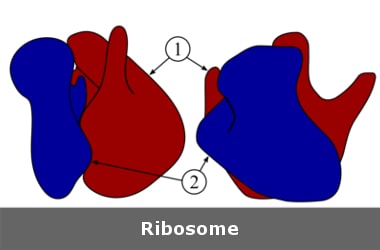 Scientists have identified a defect in the ribosome, the protein factory of the cell in 20-40 per cent of the patients with multiple myeloma which is a type of leukaemia. Scientists have identified a defect in the ribosome, the protein factory of the cell in 20-40 per cent of the patients with multiple myeloma which is a type of leukaemia.
These patients have a poorer prognosis than patients with intact ribosomes, the scientists said.
In MM patients, one part of the ribosome is produced less in 20 to 40 per cent of the patients, depending on how aggressive the cancer is.
Cells are still producing protein, but that the balance is somewhat disrupted.
One possible treatment for MM is the use of proteasome inhibitors which is the protein demolition machine in a cell. How the defects in the ribosome influence the proteasome is not quite clear yet.
Tests can now be developed to identify defects in the ribosome and thus determine which therapy will have most effect in a specific patient.
Finding that cancer is related to ribosome defects is a relatively new concept in science.
What is Multiple Myeloma?
- MM is also called Kahler’s disease.
- It is a type of Blood cancer in which bone marrow cells start increasing rapidly. It is common among older people.
|
▼ Fengyun-4 - China’s new weather satellite [12-12-16]
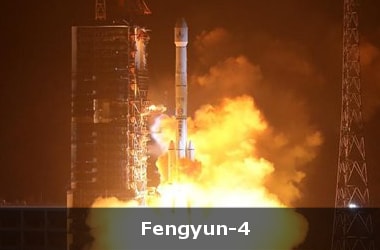 China has launched new weather satellite Fengyun-4 marking an upgrade of its meteorological satellites in geostationary orbit. China has launched new weather satellite Fengyun-4 marking an upgrade of its meteorological satellites in geostationary orbit.
The Fengyun-4 satellite is the first of China's second-generation weather satellites in geostationary orbit to have been launched.
It is also the country's first quantitative remote-sensing satellite in highest orbit.
Launched Xichang Satellite Launch Centre in southwest China's Sichuan Province on Dec 10, 2016, it was taken into orbit by a Long March-3B carrier rocket, state run Xinhua news agency.
About Fengyun-4
- One of China’s 15 weather satellites.
- 242nd mission of Long March series of rockets.
- For high time, spatial and spectral resolution observations of the atmosphere, clouds and space environment of China and surrounding regions.
- Aims at significantly improving capabilities of weather and climate forecasts.
- The China Meteorological Administration is the primary user of the satellite.
|
▼ ICGEB researchers discover a new route to ascertain drug targets [12-12-16]
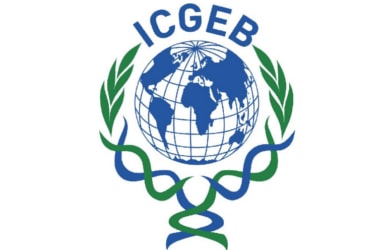 Researchers from the International Centre for Genetic Engineering and Biotechnology, Delhi in the month of Dec 2016 discovered a novel route to ascertain new drug targets and potential drugs. Researchers from the International Centre for Genetic Engineering and Biotechnology, Delhi in the month of Dec 2016 discovered a novel route to ascertain new drug targets and potential drugs.
New drug targets route and potential drugs are particularly for the parasites such as Loa loa nematode/roundworm and Schistosoma mansoni platyhelminths/flatworm that cause several diseases.
Parasites are a major cause of diseases in African nations- they have limited treatment options and are also drug resistant.
Researchers took aaRSs or aminoacyl-tRNA synthetases of the two parasites instead of blindly screening molecules which is expensive and takes a long time.
They picked up one of the enzymes that contribute to protein synthesis and authenticated it as a druggable target.
They then studied the crystal structure of the enzyme with cladosporin, a drug that targets these parasites.
It showed the acquaintance of the drug within the active site of the enzyme.
What is aaRSs?
- Stands for Aminoacyl-tRNA synthetases
- Essential enzymes that decode the genetic information and enable protein translation.
Enzyme family of aaRSs has 20 members. Each enzyme contributes to protein synthesis. If one of 20 enzymes is missing, then protein synthesis cannot happen.
|
▼ DigiShala : New TV Channel to educate masses on cashless transactions [12-12-16]
 To digitally empower millions of Indians in rural areas and educate them regarding cashless transactions, Ministry of Electronics and Information Technology on 9th Dec 2016 launched a TV channel called DigiShala. To digitally empower millions of Indians in rural areas and educate them regarding cashless transactions, Ministry of Electronics and Information Technology on 9th Dec 2016 launched a TV channel called DigiShala.
This is a free to air channel which is broadcast nationally on DD free-DTH service with a potential viewership of 2 crore across the nation.
To achieve the objective of educating, enabling and informing citizens about cashless economy, the government initiated Digi Dhan Abhiyan.
DigiShala will empower and enable citizens including farmers, students, Dalits and women to learn the benefits of digital payment according to MeitY minister Ravi Shankar Prasad.
As digital payment rises, the tax base of the nation will also increase ensuring that the country’s GDP will rise.
DigiShala will inform and educate about various digital payment options through demonstration of digital payments using UPI, USSD, Aadhaar enabled payment systems, e-wallets and cards.
Linking demonetisation to Digital India, the government will also boost digital payment through credit and debit cards, internet banking, e-Wallets and mobile apps.
Central bank through NABARD will also support Rural Regional Banks and Cooperative Banks to issue Rupay Kisan cards to 4.32 crore Kisan Credit Card holders to enable them to make digital transactions at micro ATMs, ATMs and PoS machines.
Petroleum PSUs will offer incentives by providing a discount at the rate of 0.75 percent of the sale price to consumers on purchase of petrol and diesel, if the payment is made through digital means.
To expand digital payment infrastructure in rural areas, NABARD will extend financial support to eligible banks for the deployment of 2 PoS devices in 1 lakh villages with population of less than 10,000.
This will benefit farmers of one lakh villages covering a total population of nearly 75 crore.
Railways, through its suburban railway network will provide incentive by way of discount of up to 0.5 percent to customers for monthly or seasonal tickets from January 2017, if digital payment is made.
PSU companies will provide incentive of up to 10 percent of the premium in general insurance policies and 8 percent in new life policies of LIC sold through the customer portals, if payment is made through digital means.
Union Government departments, state governments and CPSUs will ensure transaction fees/MDR charges associated with payment through digital means should not be passed on to the consumers and should be borne by them only.
In PSU banks, merchants should not be required to pay more than INR 100 per month as monthly rental for PoS terminals/MIcro ATMs/mobile PoS to bring small merchants on board the digital payment eco system.
No service tax will be charged on digital transaction charges/MDR for transactions up to INR 2000.
For payment of toll at toll plazas or national highways using RFID cards/Fast tags, a discount of 10 percent will be available in 2016-2017.
Digital India
Services offered by Digital India include:
a. DigiLocker
b. Attendance.gov.in
c. MyGov.in
d. SBM Mobile App
e. e-Sign framework
f. e-Hospital
g. National Scholarship Portal
- DigiLocker stores important documents digitally.
- BAS: Biometric attendance system part of government offices
- SBM: Swachch Bharat Mobile App is being used by people and government organisations.
- e-Sign: Citizens can digitally sign document using Aadhaar authentication
- Digital transactions have surged 400-1000% since demonetisation.
|
▼ Hot atomic hydrogen atom discovered in earth’s atmosphere [12-9-16]
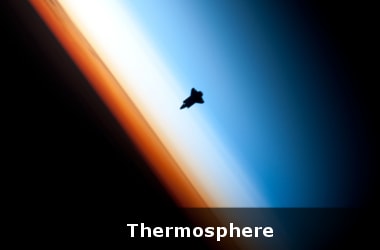 Researchers have discovered the existence of hot atomic hydrogen atoms in an upper layer of earth’s atmosphere known as thermosphere. Researchers have discovered the existence of hot atomic hydrogen atoms in an upper layer of earth’s atmosphere known as thermosphere.
The discovery changes current understanding of the distribution of hot atomic hydrogen and its interaction with other atmospheric constituents.
This discovery was enabled by development of new numerical techniques and their application to years worth of remote sensing measurements acquired by Nasa’s TIMED satellite. TIMED is Thermosphere Ionosphere Mesosphere Energetics and Dynamics satellite.
Atomic hydrogen scatters UV radiation emitted by the sun. The amount of scattered light depends on the amount of hydrogen atoms in the atmosphere
As an outcome, remote observations of the scattered H emission can be used to probe the abundance and spatial distribution of H.
To get information about upper atmosphere from such measurements, one needs to calculate exactly how the solar photons are scattered.
Researchers developed a model of the radiative transfer of the scattered emission.
This was performed along with a new analysis technique that incorporated a transition region between the lower and upper extents of the H distribution.
Temperature of the H atoms in the thermosphere was found to increase significantly with declining solar activity.
The finding is in contrast to the ambient atmospheric temperature, which decreases with declining solar activity.
Hot H atoms
- Theorised to exist at very high attitudes.
- Now found as low as 250 km.
- Ongoing atmospheric escape of hydrogen caused Mars to lose water.
- H atoms play an important role in physics governing earth’s upper atmosphere.
- It serves as a shield for satellites in low earth orbit agains the harsh space environment.
|
▼ Bacterium resistant to 18 different antibiotics [12-9-16]
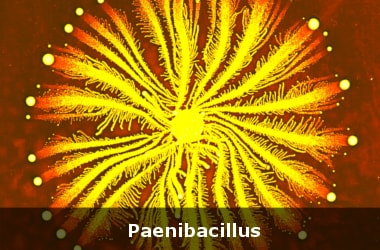 Located deep within a cave where entry is limited, scientists have found a bacterium named Paenibacillus that is resistant to 18 different antibiotics. These bugs have been living in isolation 1000 feet underground for over 4 million years. Located deep within a cave where entry is limited, scientists have found a bacterium named Paenibacillus that is resistant to 18 different antibiotics. These bugs have been living in isolation 1000 feet underground for over 4 million years.
This raises an important question– how did the bacterium become resistant to antibiotics discovered only in the 20th century.
Bacterium was found in Lechuguilla Cave which is a UNESCO World Heritage Site in New Mexico in the US. It is one of the longest caves in the world and the deepest in the US.
Because of the fragile and highly technical nature of the cave, it was only open to experts and researchers. It was originally discovered in 1986.
Restricted access makes it ideal to study how the microbes can influence human life.
|
▼ ISRO successfully launches own earth observation satellite [12-8-16]
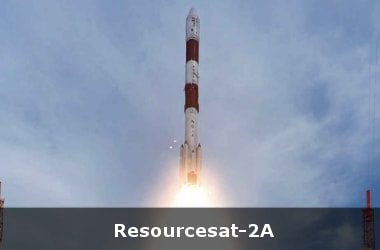 Resourcesat-2A on 7th Dec 2016 was launched by ISRO. This is its own earth observation satellite. The observation satellite Resourcesat-2A was launched with PSLV C36 from Satish Dhawan Space Centre in Sri Harikota, Andhra Pradesh. Resourcesat-2A on 7th Dec 2016 was launched by ISRO. This is its own earth observation satellite. The observation satellite Resourcesat-2A was launched with PSLV C36 from Satish Dhawan Space Centre in Sri Harikota, Andhra Pradesh.
The PSLV-XL variant rocket standing 44.4m tall and weighing 321 tonne was launched.
Resourcesat-2A is a remote sensing satellite intended for resource monitoring. It weighs 1235 kgs and was injected into the 817 km polar Sun Synchronous Orbit. It is a follow up on Resourcesat-1 and Resourcesat-2, launched in 2003 and 2011. This satellite carries three payloads which are similar to those of the Resourcesat.
The satellite aims to continue remote sensing data services to international users provided by its predecessors. The mission will provide inputs in avionic science.
It carries two solid state recorders with a capacity of 200GB each to store the image taken by its cameras. These images can be read out to ground stations.
PSLV-C36 is the 38th flight of the ISRO PSLV. The flight used the XL version of PSLV with six solid strap-on motors.
GSLV MK 3 D1; the heaviest form of the satellite will be launched by 20 January 2017.
12 more satellites will be launched in 2017 and work has been stepped up to launch Chandrayaan 2.
Know More About PSLV
- PSLV stands for Polar Satellite Launch Vehicle. It is a 4 stage engine rocket powered by solid and liquid fuel alternatively.
PSLV is an ISRO versatile launch vehicle used for launch of numerous satellites in:
- Polar SSOs
- GTO/Geosynchronous Transfer Orbit
- LEO/Low Earth Orbits
- Sub GTO
- Since 1994, PSLV has launched 121 satellites. 79 out of these were foreign satellites while 42 were Indian.
|
▼ Autonomous flying ambulance makes first successful flight [12-5-16]
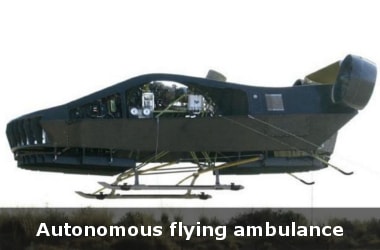 An autonomous flying ambulance has successfully completed its first solo test flight, offering a potential solution for challenging search and rescue missions. An autonomous flying ambulance has successfully completed its first solo test flight, offering a potential solution for challenging search and rescue missions.
Completing such missions in rough terrain or combat zones can be tricky, with helicopters currently offering the best transportation option in most cases.
However, these vehicles need clear areas to land, and in the case of war zones, helicopters tend to attract enemy fire.
This flying ambulance called Cormorant could one day go where helicopters cannot.
Vehicle is designed to carry people or equipment without the need for a human pilot on board.
How does the Cormorant work?
- The Cormorant uses ducted fans that are effectively shielded rotors.
- Aircraft does not need to worry about bumping into a wall and damaging the rotors.
- Another set of fans propels the vehicle forward.
- The vehicle has a decision making system to detect problems in inputs from sensors.
- It can try a different flight path or take a detour based on this system.
|
▼ New polymer patch heals heart tissues without a single stitch [12-5-16]
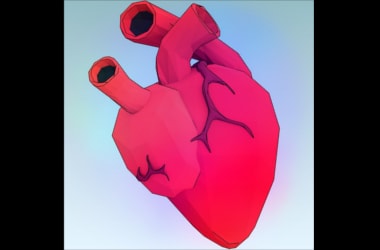 A new flexible polymer patch can improve the conduction of electrical impulses across damaged heart tissues without the need for stitches. A new flexible polymer patch can improve the conduction of electrical impulses across damaged heart tissues without the need for stitches.
The patch has worked on animal models, is long lasting and can be stuck on the heart without the need for stitches.
Heart attacks create a scar which causes arrhythmia- electrically conducting polymer patch is designed to address this problem.
Conducting polymers work when they are dry, but most become non-conducting in a very short time when placed in bodily fluids. This suture-less patch represents a big advance.
It works well across a period and prevents the need for stitches, so it is minimally invasive and less damaging to the heart.
The patch is made to adhere to the heart tissue by shining a green laser on it.
Patch can explain how conductive materials interact with heart tissues and changes associated with heart attacks.
Components of Polymer Patch
a. Chitosan
b. Polyaniline
c. Phytic Acid
- A film of chitosan, a polysaccharide is found in crab shells that is often used as a food additive.
- Polyaniline, a conducting polymer that is grown on top; and phytic acid, a substance found in plants which is added to the polyaniline to switch it to its conducting state are the other 2 components.
|
▼ Dramatic climate cycle triggered by GHG emissions led to Martian canyons and valleys [12-5-16]
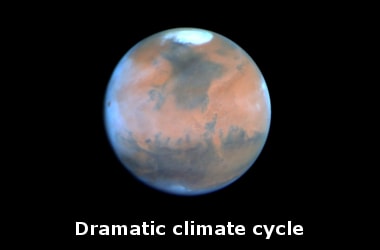 Climate cycles on early mars, triggered by GHG build up, have caused liquid water to carve out canyons and valley networks on Martian surface, according to scientists. Climate cycles on early mars, triggered by GHG build up, have caused liquid water to carve out canyons and valley networks on Martian surface, according to scientists.
Scientists have long debated how canyons and valley networks could form in Mars some 38 billion years ago at a time many hold that the Red Planet was frozen.
Researchers suggest a glacier covered early mars may have experienced long warm periods lasting up to 10 million years at a time, caused by a thick atmosphere of carbon dioxide and hydrogen.
Team found the warming cycles would have lasted long enough and produced enough water to create the features.
Previous research suggested that asteroid impacts warmed the planet, creating steam atmospheres leading to rain.
Warm periods would have much shorter durations and struggled to produce enough water.
Scientists have likened the valleys on the Martian surface are similar in width to the Colorado River Canyon. It took 16 million years for the Colorado River, swollen seasonally as snow melts in Rocky Mountains to carve the nearby Grand Canyon.
With the right choice of parameters caused by GHG reached a certain tipping point lasted millions of years on Mars - with the right choice of parameters, these warm periods last up to 10 million years.
|
▼ Now, Japanese to use fishing nets to remove space debris! [12-5-16]
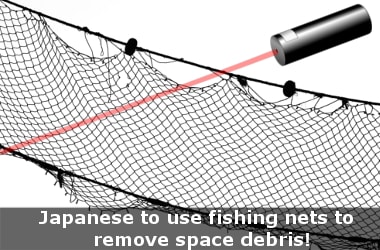 Earth’s orbit is currently cluttered with more than half a million bits of debris, mostly rocket and satellite remnants that can destroy anything in the flight path. Earth’s orbit is currently cluttered with more than half a million bits of debris, mostly rocket and satellite remnants that can destroy anything in the flight path.
The 106-year-old Japanese fishing net maker Nitto Seimo Co is working with the Japanese space agency to develop mesh material for capturing space debris.
The material will tether and drag bus sized pieces of space junk into the atmosphere for incineration.
Scientists will get the first indication of whether the metallic line will work once it is tested in orbit next month.
The Japan Aerospace Exploration Agency is leading the cleanup effort.
The experiment is part of the international cleanup effort to protect astronauts and somewhere around USD 900 billion worth of space stations, satellites and other infrastructure relied for telecommunications, weather forecasting, earth navigation and monitoring.
About Space Debris
- Space debris travels at 17,500 mph i.e. approximately 28,163 km/h.
- The impact of even a small sized projectile can cause catastrophic damage.
Space faring nations have pursued different strategies for debris namely:
- Harpooning
- Sweeping
- Lassoing
- Dragging
- The space debris are then dragged into a “graveyard orbit” where they won’t collide with operational equipment.
- NASA’s Hubble Telescope has a 1 cm hole in one of its dish antennas.
- Solar panels have been cracked by small debris.
|
▼ Technosphere: A new concept cried by Peter Haff! [12-5-16]
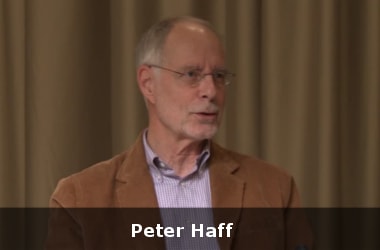 All things made by humans - from houses and roads to farms and mines– and the products used are known as technosphere. US Scientist Peter Haff has coined the term technosphere. All things made by humans - from houses and roads to farms and mines– and the products used are known as technosphere. US Scientist Peter Haff has coined the term technosphere.
It weighs about 30 trillion tons, as per an estimate made by the global team led by University of Leicester geologists.
The technosphere is enough to put 50 kgs on every square meter of the surface of the earth.
This is a new phenomenon which is expanding rapidly.
The technosphere refers to all of the structures constructed by humans to stay alive, on the planet, houses, factories,farms, mines, roads, airports and shipping ports as well as computer systems together with discarded waste.
Humans and human organisations form part of it too.
There is more to the technosphere than the production of mass– it also involves creation of everything from simple to complex items.
The Anthropocene concept- highlighted to showcase the impact humans have made on the planet- has provided a deep understanding of how humans have changed the earth.
In the distant geological future, technofossils could be used to characterise and date the Anthropocene
The technosphere is expanding at a rapid pace and is a new phenomenon in the planet.
Anthropocene
- Defines earth’s most recent geologic time period as human influenced.
- Holds that there is global evidence earth system processes are altered by humans.
Earth system processes comprise:
- Atmospheric
- Geologic
- Hydrologic
- Biospheric
- Other systems
Anthropocene = anthropo(meaning human) and cene( meaning epoch) in geologic time. - It is a new period either following or within the Holocene.
- Holocene is an epoch which began in 8000 BC around 10,000 years ago.
|
▼ Magnetic stimulation can revive forgotten memories: Scientists [12-5-16]
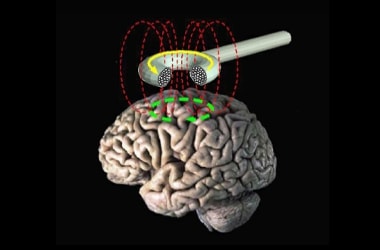 Scientists have found that stimulating the brain with magnets can aid in retrieving forgotten memories, which helps people suffering from depression or schizophrenia. Scientists have found that stimulating the brain with magnets can aid in retrieving forgotten memories, which helps people suffering from depression or schizophrenia.
Mental illness is associated with the inability to choose what to think about; scientists are now taking the first step towards mechanisms that control how we think.
Researchers have found that the brain stores less important information beyond the range of tools that monitor brain activity, and they succeeded in snapping the information back to active attention with magnets.
Researchers used a technique called transcranial magnetic stimulation to apply a focused electromagnetic field to the precise part of the brain involved in storing information.
They found they could trigger the sort of activity indicative of focused attention.
Further, if they cued research subjects, a TMS pulse would snap the stowed away memory back into attention prompting subjects to think they were cued to focus on the word.
This suggests a state of memory apart from the spotlight attention of active working memory and deep storage of more significant things in LTM.
Know the Human Brain
- The human brain weighs around 2 percent of the body’s weight.
- It uses 20% of its total energy and oxygen intake.
- The brain constitutes 73 percent water.
- It takes 2% dehydration to affect cognitive skills such as attention and memory.
- 90 minutes of sweating can temporarily shrink the brain as much as a single year of ageing.
- 25% of the body’s cholesterol is in the brain.
- Each nerve cell in the brain connects with 40,000 synapses on an average.
- All brain cells are not alike.
- The human brain generates 12-25 watts of electricity enough to power an LED light.
|
▼ ISRO set to launch 83 satellites in one go [12-5-16]
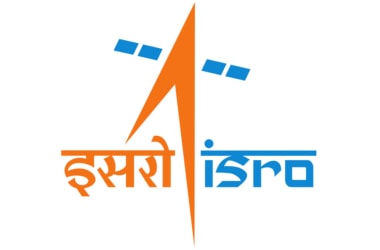 ISRO is set to launch 83 satellites, 80 of them foreign, in one go in January 2017. ISRO is set to launch 83 satellites, 80 of them foreign, in one go in January 2017.
- The 80 satellites weighing 500 kg belong to Israel, Netherlands, Kazakhstan, Switzerland and the US
- International customer satellites are being launched as a part of the commercial arrangement between them and Antrix Corporation Ltd, the commercial arm and PSU under the ISRO.
- It is the first mission of its kind in the ISRO space history.
Three Indian satellites are:
- Cartosat-2 series (weighing 730 kg as primary payload).
- INS-IA
- IB
ISRO
- Indian Space Research Organisation: Space Agency of GoI
- Headquarters: Bengaluru
- Vision: Harness space technology for national development.
- Founded in: 1969.
- It led the erstwhile Indian National Committee for Space Research (INCOSPAR).
- INCOSPAR was established in 1962, after the initiative of India’s first PM Jawaharlal Nehru and scientist Vikram Sarabhai.
- ISRO: Institutionalised space activities in India.
- Managed by Department of Space, reporting to PM (India).
|
▼ TeamIndus announces India’s first private mission to the moon [12-5-16]
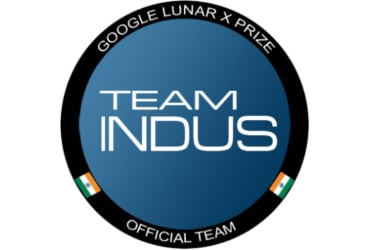 Bengaluru based private aerospace company TeamIndus has announced it will send a spacecraft to the moon on Dec 28, 2017 abroad an ISRO rocket. The mission’s aim is to land this spacecraft on the moon. Bengaluru based private aerospace company TeamIndus has announced it will send a spacecraft to the moon on Dec 28, 2017 abroad an ISRO rocket. The mission’s aim is to land this spacecraft on the moon.
It needs to travel at least 5000m and the beam high resolution video, data and images back to earth
In 2008, the Chandrayaan 1 became the first India space mission to send a spacecraft that circled the moon.
Except for the launch vehicle, all the technology powering the rover and the lander is developed in-house by Team Indus.
The company has high profile investors like Ratan Tata (Chairman Emeritus of the TATA Group) Sachin and Binny Bansal (Flipkart) and Nandan Nilekani (co-founder of Infosys Ltd)
It is staffed by a 100 member team of engineers, space enthusiasts, former Air Force pilots and ex ISRO employees
It is one of the 4 international teams and the only one from India to run the Google LunarXPrize a, USD 30 million or INR 200 crore competition to encourage private companies to launch space missions
Two US based companies Moon Express and Synergy Moon and Israeli company SPACE 1L have announced agreements with space launch vehicle companies like SpaceX
Other than technical requirements, prize rules also require the companies to be 90 percent privately funded.
Chandrayaan-1
India’s first mission to the moon.
Launched from SDSC, SHAR, Sriharikota
Date of launch: Oct 22, 2008
Spacecraft carried 11 scientific instruments built in: India, US, UK, Germany, Sweden, Bulgaria
Weight: 1380 kg (Mass at lift off)
Onboard power: 700 Watts
Mission Life: 2 years
Scientific Payloads from India:
1. Terrain Mapping Camera (TMC)
2. Hyper Spectral Imager (HySI)
3. Lunar Laser Ranging Instrument (LLRI)
4. High Energy X - ray Spectrometer (HEX)
5. Moon Impact Probe(MIP)
Scientific Payloads from abroad:
1. Chandrayaan-I X-ray Spectrometer (CIXS)
2. Near Infrared Spectrometer (SIR - 2)
3. Sub keV Atom Reflecting Analyser (SARA)
4. Miniature Synthetic Aperture Radar (Mini SAR)
5. Moon Mineralogy Mapper (M3)
6. Radiation Dose Monitor (RADOM)
|
▼ HYV varieties of Robusta and Arabica released [12-1-16]
 The Central Coffee Research Institute (CCRI) of Coffee Board is releasing high yielding and disease resistant varieties of Arabica and Robusta from time to time. The Central Coffee Research Institute (CCRI) of Coffee Board is releasing high yielding and disease resistant varieties of Arabica and Robusta from time to time.
In Arabica, ‘Chandragiri’ a semi-dwarf variety with high degree of field tolerance to leaf rust disease and high yield potential has been released for commercial cultivation during 2007-08 season.
In addition, three genotypes of Arabica have been given for multi-location trials in growers’ field during 2014-15.
In Robusta, the improved hybrid variety already developed by CCRI is most preferred among the growers because of its high yield potential and quality of beans.
Further research for development of drought resistant variety of Robusta has been taken up by CCRI.
The institute has also refined the clonal propagation techniques that supplied rooted clones of hybrid varieties to growers from 2014-2015
Coffee Board is also implementing Integrated Coffee Development Project under which various interventions such as
- Research & development,
- Technology transfer,
- Capacity building,
- Replacing the old unproductive varieties with improved high yielding/disease tolerant varieties, water augmentation
- Mechanisation etc. are undertaken for the overall improvement of production, productivity and quality of coffee.
|
▼ HIV Self testing for first time! [12-1-16]
 The WHO for the first time has recommended HIV self-testing in the privacy of one's home using HIV kit. This is a move that may result in a major breakthrough in HIV treatment by improving access to diagnosis. The WHO for the first time has recommended HIV self-testing in the privacy of one's home using HIV kit. This is a move that may result in a major breakthrough in HIV treatment by improving access to diagnosis.
The UN agency's guidance has even prompted the health ministry here to evaluate the proposal.
Lack of HIV diagnosis is one of the biggest problems of this disease
Estimates show around 87% of HIV-infected people in India are not even aware that they are suffering from the disease and may be unknowingly spreading the virus.
Globally, around 40% of all people with HIV or over 14 million remain unaware of their status.
Self Testing and HIV AIDS
- Particularly relevant for people who find accessing tests in clinical settings difficult.
- Results of the test can be seen within 20 minutes or less.
- Those with positive results are advised to seek confirmatory tests at health clinics.
- In 2015, the total number of people living with HIV in India were estimated at 21.17 lakh.
- Around 86,000 new HIV cases were found.
|
| Chronology of events |
|
NE Space Application Centre will use drones to assess areas damaged by natural disasters for the first time.
|
|
Indian Council of Medical Research (ICMR) on Dec 1st signed an MoU with Indian Council of Agricultural Research (ICAR) for cooperation in the area of zoonoses, anti-microbial resistance, nutrition and pesticide residues.
|
|
Scientists have created the first ‘water-wave laser’ that emits a beam through the interaction of light and water waves, and may be used in ‘lab-on-a-chip’ devices to study cell biology and test new drug therapies.
|
|
Scientists in Russia have developed a unique, low-cost method for producing high-quality nuclear fuel using electricity. The main type of fuel for nuclear power reactors is the uranium oxide pellet composition.
|
|
Tweet any emoji at Google and get relevant search results as per a new feature rolling out from Dec 7, 2016.
|
|
Sprint Corp said on Dec 7, 2016 it would partner with the developer of Pokemon Go, Niantic Inc, in a bid to entice fans of the wildly popular location-based game.
|
|
In a bid to reach out to its ex-servicemen, the Indian Army has launched a mobile application 'Veterans Outreach App', an official statement said on Dec 7, 2016.
|
|
'Jinie' is India's first HR chatbot, with human resources solutions and technology company PeopleStrong on Dec 8, 2016 launching the chatbot which aims to shift HR from a transactional interface with employees to a conversational interface that is engaging and creates an impact.
|
|
A new spider species discovered by Mumbai researchers in the central Western Ghats has been scientifically named Eriovixia gryffindori, after the fictitious wizard, Godric Gryffindor; it was named so because it resembles the magical hat worn by the wizard.
|
|
Challenge in which around 100000 people participated to test Albert Einstein’s understanding of the microscopic world was the BIG Bell Test.
|
|
Stephen Hawking's search for new habitable planet in Dec 2016 was supported by NASA.
|
|
Snapchat rolled out a feature on 13th Dec for group chats with up to 16 people as the fast-growing social network sought to broaden its services.
|
|
Pokemon Go, an augmented reality game is finally making its debut in India.
|
|
Drugs and Cosmetics Rules, 1945 being amended to prohibit misleading advertisements of Ayurveda, Siddha & Unani Drugs: AYUSH Minster
|
|
As per Juniper Research, by 2021, the number of connected devices, sensors and activators in use will total 46 billion marking a 200% jump on the number of IoT devices linked to the web.
|
|
Scientists have discovered a jet stream within the Earth's molten iron core using the latest satellite data that helps create an 'X-ray' view of the planet, which is likely to be caused by liquid in the core moving towards this boundary from both sides, which is squeezed out sideways.
|
|
China has commissioned AC352, its first seven-tonne helicopter marking a new development in the China’s helicopter industry; It is a multi-purpose twin-engine helicopter with a 7.5-tonne maximum take-off weight and is capacity of up to 16 passengers.
|
|
US based researchers for the first time have observed the creation of ice crystals on individual atmospheric particles in the laboratory for the first time.
|
|
Researchers from United States have developed the first vaccine for Chikungunya fever made from an insect-specific Eilat virus.
|
|
The Ministry of Textiles has decided to establish a “Bunkar Mitra-Handloom Helpline Centre” where professional queries of weavers will be answered by the experts in the field. This helpline will function from 10.00 a.m to 6 p.m. and initially it will be provided in 7 languages viz., Hindi, English, and 5 other regional languages (Telugu, Tamil, Kannada Bengali & Assamese).
|
|
Experimental ebola vaccine tested on humans in the waning days of the West African epidemic has been shown to provide 100 percent protection against the lethal disease; an emergency stockpile of 300,000 doses has already been created for use should an outbreak flare up again.
|
|
The new service launched by Google to enhance public convenience is- Google Map toilet locator.
|
|
China has tested the latest version of its fifth-generation stealth fighter. The new FC-31 has “better stealth capabilities, improved electronic equipment and a larger payload capacity” than the previous version
|
|
Mori, a village under Sakhinetipalli mandal in East Godavari district of Andhra Pradesh, today sealed its place on India’s digital map by transforming completely into a Smart Digital Village, in every sense of the term.
|
|
China has started operations of one of the world’s longest high-speed railways (bullet train) with the 2,252 km Shanghai-Kunming line which is also the longest east-west high-speed railway in China.
|
|
Researchers have developed an automated technology that combines imaging with digital analysis and machine learning to help physicians detect melanoma at its early stages.
|